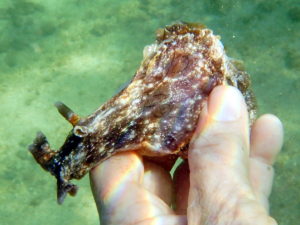
A white-speckled sea hare. ©Susan Scott
October 16, 2020
In 1983, after enrolling in an invertebrate zoology course at UH Manoa, the early classes disappointed me. I just could not get enthused about phylogenetic systematics or unicellular eukaryotes. But then, for a lab lesson, the professor took the class to the Diamond Head reef flats during low tide, and my opinion of the subject soared. There on Oahu’s south shore, I found my first sea hare, and with that discovery, my lifelong infatuation with marine invertebrates began.
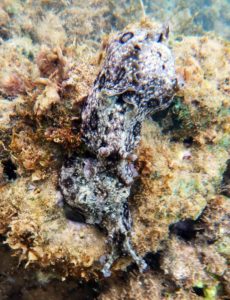
These two speckled sea hares are mating. Like all sea slugs, sea hares are hermaphrodites, each individual having both male and female reproductive organs, therefore, doubling their chances of procreating. ©Susan Scott
Sea hares are relatives of the large group of creatures we call sea slugs. The word slug doesn’t conjure up a pretty image, but the oceans’ version of slugs is another universe from terrestrial slugs. Sea slugs are among the most beautiful animals on the planet.
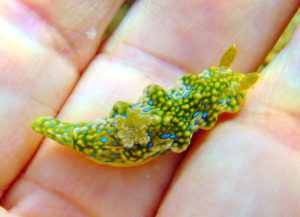
One of my all-time favorite nudibranch discoveries, a gorgeous, tiny and rare Hawaii species nicknamed the jolly green giant. ©Susan Scott
Sea hares won’t win any beauty contests in color, because most species are brown, gray or black. The Hawaiians named all sea hares kualakai, but the animals’ common English name gives away one charming feature: bunny ears.
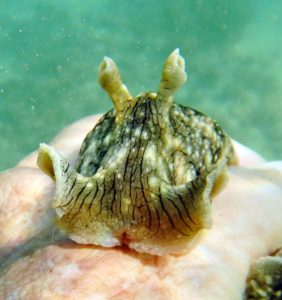
The front of a white-speckled sea hare. ©Susan Scott
They aren’t really ears, but the pair of tentacles that rise from the top of the creature’s head are sensory organs that reminded someone of rabbit ears. Hares and rabbits are different species, but their names are commonly interchanged. The jackrabbit, for instance, is a hare, the rockhare is a rabbit, Bugs Bunny is a wabbit, and a sea hare is an anaspidean mollusk.
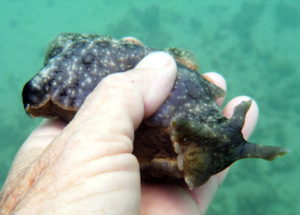
This white-speckled sea hare unfurled its front two tentacles into a flat flap when I picked it up. ©Susan Scott
Unlike real hares and rabbits, sea hares have four earlike structures, one pair on top of the head and another pair pointing forward, sometimes furled, sometimes open and flat.
Hawaii hosts at least 14 species, all beautifully photographed and explained on the Hawaii sea slug site, bit.ly/2H2fwuT The largest, the white-speckled sea hare, grows to 8 inches long, maybe longer. The ones I commonly see are usually 5 or 6 inches.
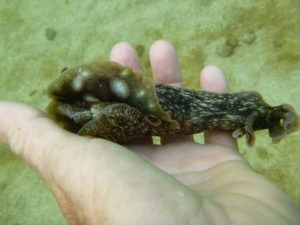
The well-named white-speckled sea hare, native to tropical and subtropical waters worldwide, is common in Hawaii. ©Susan Scott
All are vegetarians, sheltering under rocks and in cracks during the day and roaming the reef at night to graze on seaweeds.
Most of us think of sea slugs as snails without shells, but most sea hares have evolutionary remnants of a shell on their backsides, sometimes visible, sometimes not. But if you pick up a sea hare, you can usually feel the hard curve of its skin-enclosed shell.
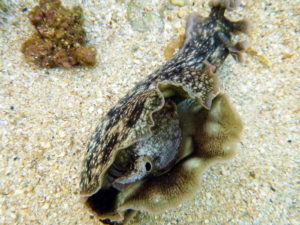
You can clearly see this sea hare’s shell shape under its open back flaps. ©Susan Scott
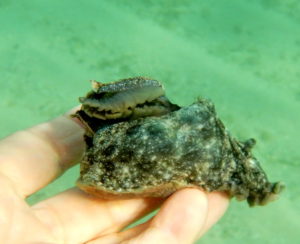
This sea hare showed me its gills under its raised rear shell. ©Susan Scott
Like their sea slug relatives, sea hares carry toxins in their bodies, recycled from the seaweeds they eat. One species is what we in Hawaii call stinging limu (Lynbya majuscala), because when adrift in the water column, the seaweed causes a rash on the skin of swimmers and surfers.
I don’t casually pick up sea hares, not because they can hurt me (the toxin is inside their bodies), but because it upsets them so. I know this because the ones in my neighborhood spew clouds of reddish purple when I handle them. But last week, after our first North swell of the season, I found two sea hares rolling in the surf on separate days, the waves apparently having rousted the creatures from shallow sleeping spots.
To rescue the sea hares, I had to carry them to deeper water outside the break. Before I could tuck them into their rocky beds, however, both hurled.
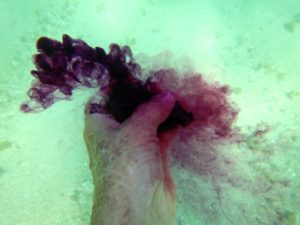
©Susan Scott
This colorful cloud is a likely a defense against potential predators. The release only occurs in sea hares that eat red algae, species abundant on my reef.
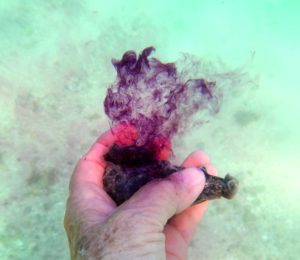
©Susan Scott
All those years ago, the invertebrate zoology courses I took required that I learn the vocabulary of the field, a process I found rather painful. But finding that sea hare put life in the learning, and that made all the difference. Most snorkelers and divers aren’t particularly thrilled when they find a sea hare, but I always am. Because they opened the door to a lifetime of pleasure, those wascally wabbits remain close to my heart.